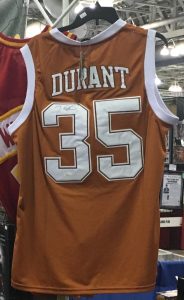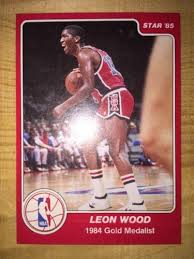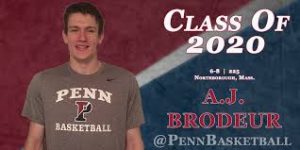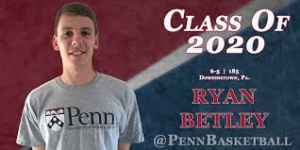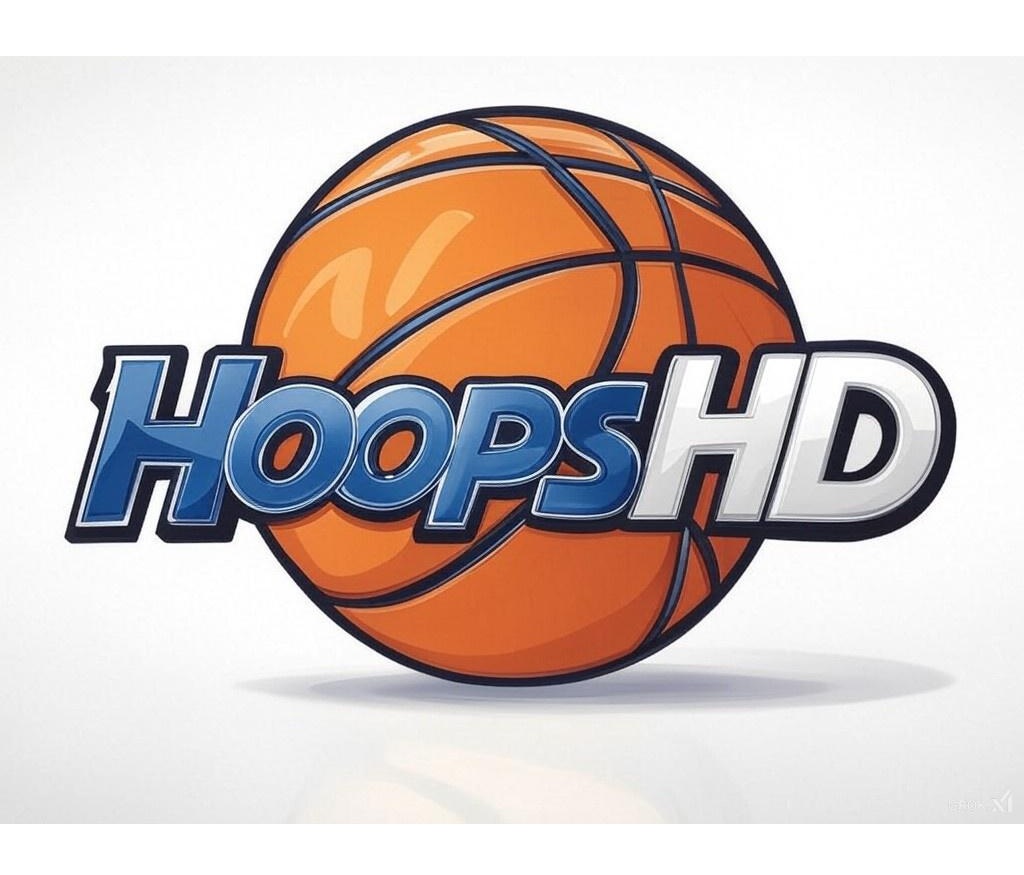The National Sports Collectors Convention (nsccshow.com) is an annual summer gathering of collectors/dealers who have a passion for trading cards, autographs, and any kind of memorabilia that you can think of. First formed in 1980, it is now the premier collectibles industry event that attracts a majority of the licensing agencies from around the professional sports world. The 37th “National” was held during the 1st week of August at the Atlantic City Convention Center, and next summer it will head back to the Midwest in Chicago. HoopsHD’s Jon Teitel attended this year’s event and will present photo essay installments of all the college basketball merchandise he saw in person.
The runaway winner for most college basketball-related items at a single booth was Jon English of Vintage Sports Antiques (vintagesportsantiques.com), a guy from Tennessee who spent much of his life in the commercial industrial construction business. He had a wide array of merchandise but the one that caught my eye was his collection of primarily black and white wire photos. They capture a specific moment in time and like a delicious potato chip most collectors cannot be satisfied with only 1. Jon has grown his own collection via decades worth of trips to flea markets/antique malls while his friends were out partying. He has always loved history and collecting these very unique items has allowed him to hunt for treasure on land: here are my 10 favorites:
- Bill Bradley finished his Princeton tenure as national POY in 1965 with 2503 career PTS, which remains the most in Ivy League history. After graduating he was drafted by the Knicks but decided to take his talents to Oxford as a Rhodes Scholar. In 1967 he signed his rookie contract aside Madison Square Garden Corporation president Irving Mitchell Felt and Knicks president Ned Irish, and in 1983 he was inducted into the Hall of Fame. Most of Jon’s photos are on sale for $25 or less, but due to the Oxford surcharge it will cost you $45.
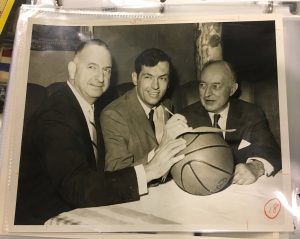
- On Valentine’s Day in 1944, Notre Dame took a trip to the East Coast to play NYU at Madison Square Garden. The Irish emerged with a 59-53 win and the CYO individual award was presented to All-American Leo Klier. He spent the following season serving in the Navy during WWII, then returned to campus and was named All-American again in 1946. Also seen in this photo is Klier’s coach Ed “Moose” Krause, himself a 3-time All-American who was inducted into the Hall of Fame in 1976. You don’t have to kiss me, but if you’re Irish then you can pick up this pot of photographic gold for $25.

- 1960 was a big year for Terry Dischinger: the 3-time All-American at Purdue began the year with this shot over Wisconsin, then spent the summer winning an Olympic gold medal in Rome as the youngest member of team USA. His NBA career started off hot with 3 All-Star games in his 1st 3 seasons, but after spending the next 2 years in the Army he retired in 1973 to become an orthodontist. Smile for me, especially if you have $15 to purchase this 1.
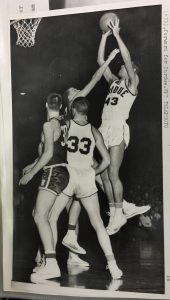
- This 1 is both the most tragic and the most special to me. In the 1970 NCAA tourney Bob Lanier had 26 PTS/14 REB in a win over Villanova but injured his knee with 9 minutes left and was unable to play in St. Bonaventure’s 8-PT loss to Jacksonville. I interviewed Bob about this injury a few years ago and asked him if he felt that his team would have won if he was healthy. He said that they had a legitimate shot of winning the title and thinks that they would have beaten Jacksonville but for the injury. I have read much about it but never seen a photo of it before…until now, but even for $15 it is still painful to look at.
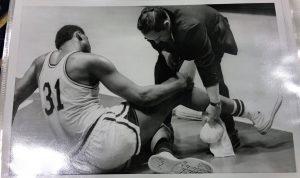
- You do not see too many games these days featuring a pair of NCAA tourney MOPs facing each other because they are either 1-and-done freshmen (Anthony Davis) or seniors who wins the award in their final game (Ryan Arcidiacono). Back in the day it was a much more common occurrence, and here is the proof with Utah and Oklahoma A&M preparing for a doubleheader at Madison Square Garden in the mid-1940s (the photo is dated 12/11/44 but I cannot find proof of the teams playing around that time). The Utes were led by 1944 tourney MOP Arnie Ferrin (who won back-to-back NBA titles in 1949/1950) while the Cowboys’ big star was 7-footer Bob Kurland (the 1945/1946 tourney MOP who won a pair of Olympic gold medals in 1948/1952). If you like winners, and have $50, then this can be yours.
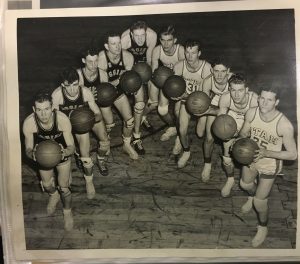
- The SEC may be the king of football but they have some pretty sweet basketball history as well. On 1/12, 1970, 2nd-ranked Kentucky went into Stegeman Coliseum and emerged with a 72-71 win for Coach Adolph Rupp. Georgia’s Bob Lienhard had 17 PTS and pounded the boards for a ridiculous 24 rebounds in defeat. Leading the way for the Wildcats was All-American Dan Issel who scored 32 PTS on 13-21 FG. This photo of the 2 big men battling shows how intense things got when fighting for the ball down in the post, and to capture the essence of all 40 minutes you will have to shell out $40.
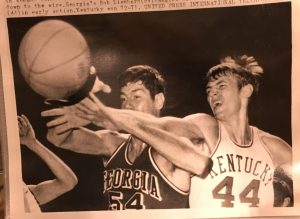
- Before he became 1 of the top-25 AST men in NBA history, before he created a program to help other athletes with their own drug rehabilitation, John Lucas was 1 of the best tennis players in ACC history. No, seriously: an All-American tennis player at Maryland, he won the ACC #1 singles championship twice in 3 years, played World Team Tennis with San Francisco/New Orleans, and in 2005 he even coached Steffi Graf with the Houston Wranglers! He was also a 3-time All-American basketball player for the Terps and ended up being selected #1 overall by Houston in the 1976 NBA Draft. This photo shows the aerial prowess of #15: the fact that the price is also $15 just shows how nice it is when things work out.
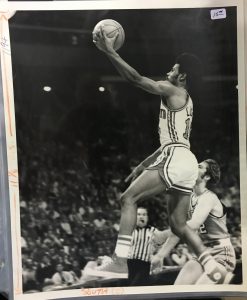
- Kevin Stallings is preparing for his 1st year on the sideline at Pitt, and if it goes as well as his last year as a player then it could be a sensational season in Steel City. On 3/24/80, Stalling and Joe Barry Carroll helped lead the Boilermakers to a 75-58 win over Iowa in the national 3rd place game while Louisville beat UCLA to win the NCAA title. Carroll went on to be selected 1st overall by Golden State in the 1980 NBA Draft while Stallings has won 450+ games as a coach at Illinois State/Vanderbilt, so they both turned out okay. Season tickets in the Oakland Zoo are not cheap, but for $25 this 2-shot is priced just right.
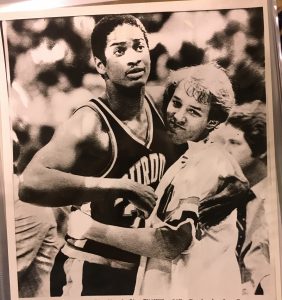
- On 1/18/67, Wes Unseld and Lousiville took a road trip to Dayton and pulled out a 66-5o win over the Flyers. The best visual representation of a “Flyer” was 2-time All-American Don May, who is seen here leaping right over the future Hall of Famer for an easy layup. They each won an NBA title in 1970s, so if you like champions then we would like your $25.

- Last but certainly not least is 2-time All-American Bernard King posing for an action shot at Tennessee. The Volunteer family recently lost their best coach ever when Pat Summitt passed away in June, but the co-star of the “Bernie & Ernie” show is still going strong at age 59. He led the NCAA with 62.2 FG% as a sophomore, grabbed 14.3 RPG as a senior, and was named SEC POY for 3 straight years. Despite having numerous injuries during his NBA career, he remains 1 of the top-50 scorers ever and was inducted into the Hall of Fame in 2013. It is hard to find a Hall of Famer who will give you his autograph for $25, but for that same price you can own this gorgeous photo of 1 of the best college scorers we have ever seen.


